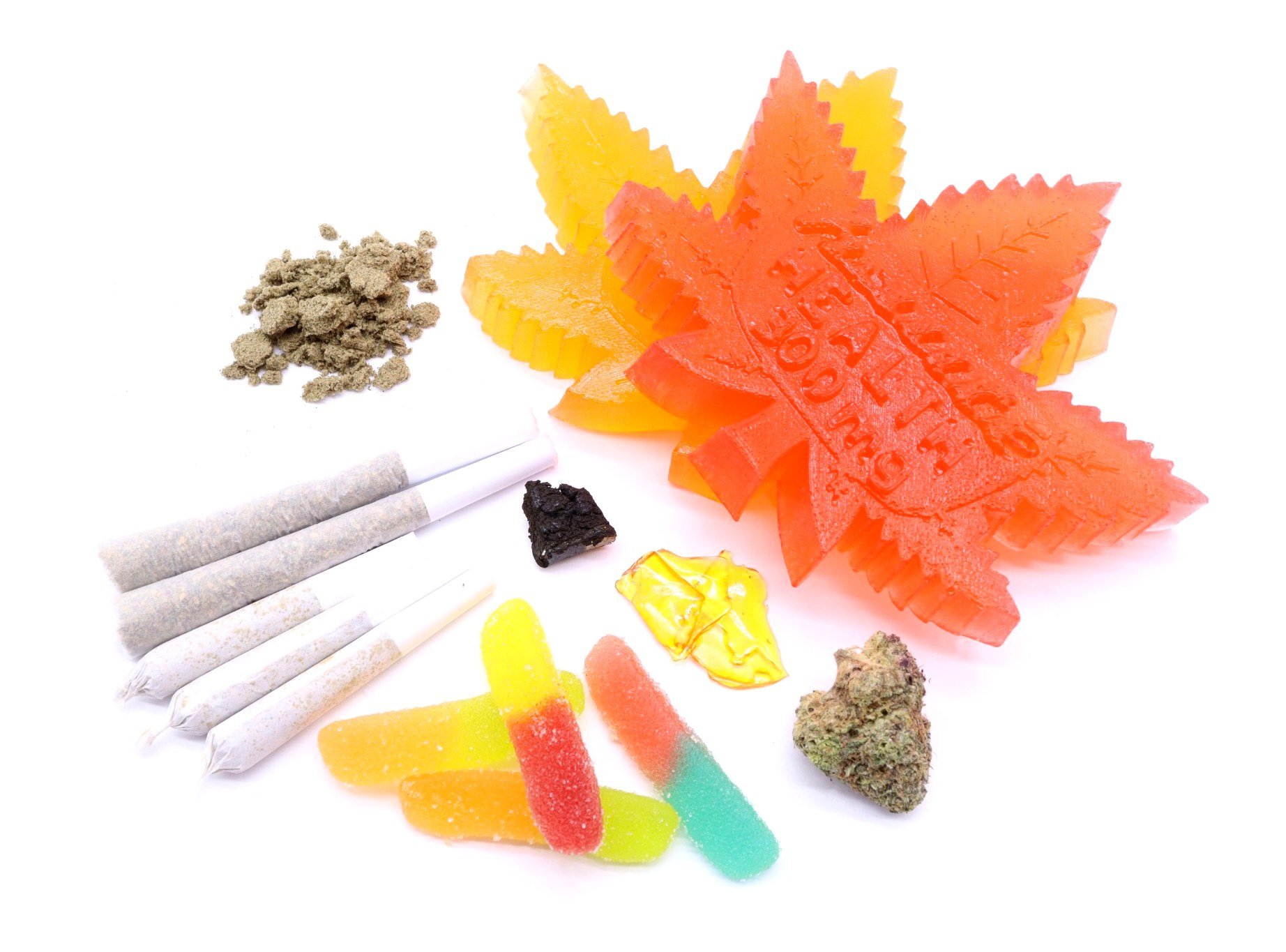If you suffer from travel anxiety, you hate flying, you get stressed easily or if you have to travel a lot for your job then you’re probably one of those people who appreciates cannabis on the road/in the air. Cannabis has long been considered a “must have” for weary travelers because of its effects on the mind & body. Some of the effects are a godsend for traveling – eases anxiety, reduces pain or inflammation, can soothe nausea and helps you to sleep deeper & more consistently. Other effects like psychoactivity, lethargy, or even the uncontrollable munchies don’t sound appealing to some, but most people who trust in cannabis as a travel-aid will tell you that it’s a major part of managing their travel stress.
Are you or someone you know a loud & proud “high traveler”? If not, have you ever wondered what your traveling life could be like if you just gave weed a chance? Traveling with edibles in Canada might not seem like a recipe for success, but maybe it’s exactly the kind of thing you need to overcome your road-weary woes?
It’s time to learn the benefits of flying with cannabinoids in your system. In this travel guide we’ll consider how much weed you can travel with in Canada, crossing borders with edibles or joints safely, and the challenges of flying with cannabinoid products due to the overabundance of “security measures” associated with modern travel.
HOW MUCH WEED CAN YOU FLY WITH?
It’s one of the first and only things most stoners want… no, NEED to know about traveling with cannabis: how much weed can you travel with in Canada?! The answer will depend on whether you’re a licensed medical cannabis user, but anyone else (which is most of us) will get the same answer: 30 grams or equivalent. In Canada, the legal possession limit you are allowed to travel with can be calculated according to the following chart:
POSSESSION LIMITS OF CANNABIS, EQUIVALENT VALUES:
1 gram of dried cannabis flowers
5 grams of fresh cannabis
15 grams solids containing cannabis
70 grams non-solids containing cannabis
0.25 gram cannabis solids concentrates
0.25 gram cannabis non-solids concentrates
1 seed from cannabis plant
This chart depicts the legally acceptable possession limits of cannabis equivalency values. We mentioned that 30 grams of dried cannabis flowers (or equivalent) was the limit, so to calculate how much weed you can travel with in Canada simply times whatever class of cannabis you have by ‘30’.
For example, the following chart provides the legal limits on how much weed you can fly with according to your basic possession rights as a Canadian cannabis user:
30 grams of dried cannabis flowers
150 grams of fresh cannabis
450 grams solids containing cannabis
2100 grams non-solids containing cannabis
7.5 grams cannabis solids concentrates
7.5 grams cannabis non-solids concentrates
30 seeds from cannabis plant
When it comes to crossing provincial borders with edible cannabis beverages or flying with cannabinoids in liquid form it’s generally assumed that ‘grams’ are equal to ‘milliliters’. For instance, the 2100 grams of non-solids containing cannabis might be liquids or gasses, but in either exchange the conversion ratio is typically assumed to be 1:1. This might not be true in all cases, so if you’re ever unsure when traveling with cannabis in liquid/gas form just take less to be on the safe side.
If you aren’t sure how much cannabis of a certain product type you have, then you need to invest in working scales. Digital scales or measuring systems don’t cost an arm nor a leg these days, and it’s a useful tool moving forward if you get into growing your own or producing your own edibles, concentrates or topicals. All legally purchased cannabis products have strict requirements & limitations on their packaging size to accommodate these possession limits, but if you grow your own or buy from other sources then just double-measure them to be extra sure.
CROSSING BORDERS WITH EDIBLES, JOINTS OR CONCENTRATES
Have you ever been about to travel from province to province and wondered: can I bring edibles on a plant within Canada? Flying from BC to Ontario is a long ordeal, and no matter where you’re flying within Canada it can mean lots of layovers, delays and inordinate amounts of time stuck in airports. This is where an edible can be the perfect travel trick because they don’t kick in right away, they have potent effects and often last for longer periods of time.
You obviously have to have confidence in your cannabis tolerance levels for THC to pull this travel hack off. You also must have the ability to get taken to the airport by someone else or via public transit – NEVER operate any vehicles while under the influence of cannabis, especially edibles or concentrates. There’s a trick to timing when to take your edibles before flying within Canada because you can’t take them through security with you.
If you’re seeking some mellow or better sleep for your skyway travels, start with some low dose cannabis edibles and see how they sit with you. After a few practice rounds you’ll find what works, what doesn’t but always be mindful that edibles are unpredictable and can kick in late or last longer than you anticipate. Always plan far ahead for both getting to and from the respective airports.
Now comes the downright depressing part of the conversation about crossing borders with edibles… You can bring edibles on a plane within Canada if it’s under the possession limit, but how about flying with cannabinoids internationally? The answer is a downright N-O. It is illegal to transport cannabis across borders, even if the the place you’re coming from (like Canada) recognizes your rights to possess cannabis AND even if the place you’re going is similar (such as Mexico, who are now also Federally legalized).
Cross borders with edibles, joints, concentrates, topicals or plain old buds is a sure way to get yourself in a lot of trouble. For now, the only feasible way of crossing borders with edibles or other cannabis products is to stay within Canadian borders. In the United States it is equally prohibitive to cross State borders with cannabis in your possession, but if you’re driving from one cannabis-friendly State to another then there are exceptions as long as the amounts are limited to personal use. So, traveling with edibles within Canada is no longer an issue! That’s a win for sure, we just hope international restrictions on cannabis open up soon. C’mon other countries, it’s the 2020’s!
WEED TRAVELING CHECKLIST
So we know how much weed you can travel/fly with in Canada, we understand that traveling with edibles within Canada can be done, and we figured out that crossing borders with edibles, joints, concentrates or topicals is definitely a no-no. Now what’s left to cover? Flying with cannabinoids contents, whether it’s medical or recreational, requires you to be extra careful because even if you know your rights there will undoubtedly be those security agents that push the limits or target you because of their own self-righteous stigmas towards weed. For this reason among others, let’s go over a simple checklist of things to do or bring along with you whenever you’re traveling with cannabis in Canada.
STORAGE CONTAINER
The first and most important thing you must bring with you when flying with cannabis products is a sealable, no-smell, secure storage container. A dimebag won’t cut it when traveling with weed in Canada – you need to bring your personal allotment of buds in a no-smell container that can be locked/sealed.
Your weed containers also have to fit in your carry on or checked baggage, obviously. Most traveling stoners would recommend that you bring your cannabis with you in your carry on. This isn’t an official stance by airport security, but you can imagine that they might show bias to your luggage if there’s cannabis in there, even if it is your legal right to possess it. To avoid your bags being delayed or held off the flight altogether, bring your cannabis with you and go through the necessary security checks where you can explain its use and defend your cannabis rights.
ACCESSORIES
If you’re going to be consuming your cannabis at your destination, you’re going to need accessories like pipes, bongs, lighters, vaporizers and more. You can research the city/town you’re traveling to and see if they have local stores. That being said, it’s always safest to bring your own accessories – not to mention it’s cheaper than buying new sets every time you travel.
Like with the cannabis itself, many people choose to store their accessories with their carry-ons because many accessories are fragile or expensive. Some airlines don’t allow equipment or glass items on the passenger areas of the plane, so you might have to acquiesce and store these in your luggage.
CARE PACKAGE
A ‘care package’ for traveling cannabis users will be unique to their own weed needs. Some people might want to bring vitamins or supplements that help them after “greening out” – for those times when the edibles kick in too hard. Others include some hemp CBD tinctures or travel with CBD edibles to counteract the THC if it becomes overwhelming. Hemp is treated differently than cannabis, so pure hemp CBD can be counted outside your personal possession allotment.
Other care package items might include munchies, hydration, cover-up aromas to hide your cannabis smells, or even cosmetic items that can counteract weed-related red eyes for those trips on red eye flights.
RECORDS
Last but not least, you need to bring any records, licenses or relevant paperwork that might help get you out of a bind when flying with weed within Canada. If you have a medical license for cannabis then you will likely have a much greater capacity for cannabis possession and consumption (i.e. 50 grams or more personal possession limit). You will also have access to far more potent cannabis formulations for your medical needs as a license holder. This highlights how essential it is that you provide your medical license and any relevant records (prescriptions, doctor’s notes, etc).
If you’re not a medical licensee there are still some records that can help you avoid friction with security or law enforcement. Transaction records, receipts, invoices or even emails that detail where you got your cannabis and how much will ward off any suspicion. Records like past medical history with cannabis, even if you’re not a license holder, can also go a long way towards protecting your rights to use cannabis from those people who can’t get with the times.
There you have it! You’re packed and ready to fly high (literally). Now that you know how much weed you can travel/fly with within Canada and you know what to bring, what not to do when traveling with cannabis the only thing left is to pick a destination. Happy travels, and remember not to let the road woes wear you down – with cannabis in your pocket there’s no journey you can’t cruise through.


